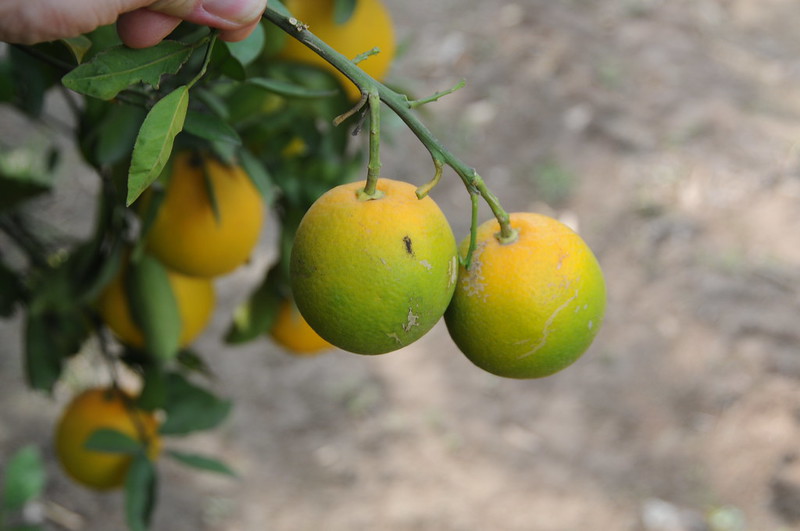Combating Citrus Greening Disease
ARS combats citrus greening disease through disease detection, prevention, and mitigation research. In 2021, the California Department of Food and Agriculture (CDFA) confirmed 2,510 trees in 5 counties were infected, including the county where the ARS Citrus Germplasm Collection is located. This is an increase in infected trees reported from the past 2 years. The Citrus Research and Field Trial (CRAFT) program is in its third year supporting citrus replant efforts across all citrus-growing regions of Florida. Nearly 5,000 acres of new citrus planting are part of CRAFT research projects. The following ARS advancements in 2021 highlight ongoing citrus greening response efforts.
Biotechnology improves early detection of citrus greening bacteria. Early detection and rapid response are the keys to mitigating citrus greening. Pennsylvania State University and ARS researchers in Fort Pierce, Florida, have used cutting-edge CRISPR/Cas technology to develop a diagnostic test that could enable early diagnosis of citrus greening, or huanglongbing (HLB). The new assay can detect the presence of the disease's causal agent—the bacterium Candidatus Liberibacter asiaticus (CLas)—at a sensitivity level 100 to 1,000 times greater than the commonly used qPCR diagnostic test. The new assay called DETECTR, or DNA endonuclease-targeted CRISPR trans reporter, is compatible with current technology and holds promise for providing a rapid and economical test for citrus greening in the field.
A parasitoid used to control pests transmits citrus greening. Parasitoids are frequently used in biological control and integrated pest management strategies all over the world. ARS researchers in Fort Pierce, Florida, demonstrated for the first time a risk posed by these control agents. Deployment of parasitoids has been promoted as a means of suppressing Asian citrus psyllid (ACP), a pest that transmits citrus greening disease , or HLB, in citrus orchards. However, while controlling ACP, the parasitoid Tamarixia radiatacan inadvertently vector the HLB pathogen CLas. This diminishes Tamarixia radiata’s biological control efficiency, particularly in orchards where CLas-infected and uninfected asymptomatic citrus trees coexist. This finding presents a new and significant caution to the strategy of implementing biological control using parasitic wasps.
Two for one: new technology detects two citrus pathogens in one test. Citrus greening is managed in California by intensive surveys and immediate eradication. Detecting citrus greening is complicated by the presence of citrus stubborn disease, which is caused by a different pathogen than the citrus greening pathogen. However, trees infected with either pathogen exhibit symptoms that are similar, resulting in misidentification and complicating citrus greening control and eradication efforts. ARS researchers in Parlier, California, developed two different PCR tests that can rapidly differentiate between the two pathogens populations. These methods provide clear quantitation of pathogens, which is critical when there are only low concentrations of target DNA and is critically important in regulatory programs involving mandatory eradication.
There are more insect pests in citrus orchards in China than previously known. Citrus is an important commercial crop throughout the world and citrus pests severely limit production and economic returns. Scientists in the ARS-associated laboratory in Beijing, China, conducted surveys of citrus pests in China, which is one of the centers of origin of citrus. Collected insects from citrus orchards in China underwent DNA analysis and were grouped as either pests or beneficials. Results showed that the number of pests is much higher than has been documented in literature. The data generated in this study provide a valuable resource for research in a broad range of areas, such as citrus pest management and monitoring programs.
 Keres, Preston. A Swallowtail butterfly visits Goldpetal Farms in Chaptico, Md., July 17, 2021. USDA Photo. https://flic.kr/p/2mc1ouQ
Keres, Preston. A Swallowtail butterfly visits Goldpetal Farms in Chaptico, Md., July 17, 2021. USDA Photo. https://flic.kr/p/2mc1ouQ

